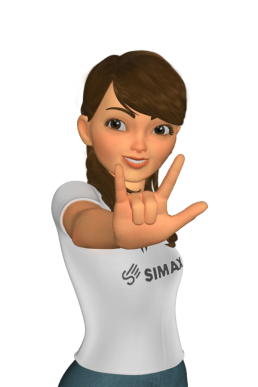Unlike the traditional way of producing sign language translations, SiMAX does not need a film studio or sophisticated video technology. With a learning database in the background and sign language professionals, SiMAX translates your content into 3D-animated sign language. Once your text changes, SiMAX can update the translation quickly and cost-effectively
The traditional production of sign language translations is time-consuming and expensive: the translation is recorded by human actors in a video studio. The videos have to be edited in the post-production department. If a part of the translation changes, the entire translation has to be re-recorded. Thanks to the learning database, SiMAX enables translations to be created with a fraction of the time and cost. This makes it economically viable to translate large amounts of content.
Schriftsprache ist eine abstrakte Form der Lautsprache. Wer die Lautsprache nie gehört hat, hat daher Schwierigkeiten, Schriftsprache zu verstehen. Aufgrund dieser Schwierigkeiten sind schriftliche Informationen für Gehörlose eingeschränkt zugänglich.
Like all natural languages, sign language is subject to national and regional differences. In most countries there are national sign languages which are expressed in different dialects.
Gebärdensprache unterscheidet sich von einem Land zu anderen. In Österreich wird zum Beispiel ÖGS (Österreichische Gebärdensprache) verwendet, in Deutschland DGS (Deutsche Gebärdensprache) und in Nordamerika ALS (American Sign Language).
Lip-reading is not an alternative to sign language. Lip-reading is based to a large extent on guesswork, guessing and the interpretation of hints from the context of the words. By reading lips, only about 30% of the information can be understood.
According to the World Federation of the Deaf (WFD), 70 million people worldwide are deaf.
Accessibility requirements are already enshined in Austrian law:
- For example in the Federal Constitution Act paragraph 7 (Equal treatment of disabled and non-disabled people in all areas of daily life) and paragraph 8 (acknowledgement of sign language as an independent language)
- In der UN Convention on the Rights of Persons with Disabilities, in force since March 2008
- In the Federal Disability Equality Act
- In the E-Government Act: All public websites must be accessible and therefore also offer translations in sign language.
In Germany: Ordinance on the creation of barrier-free information technology according to the Disability Equality Act (Barrier-free Information Technology Ordinance – BITV 2.0).
In Europe: European Disability Strategy 2010-2020 of the European Commission.
In the USA: ADA Amendments Act of 2008: “Physical or mental disabilities in no way diminish a person’s right to fully participate in all aspects of society”.
